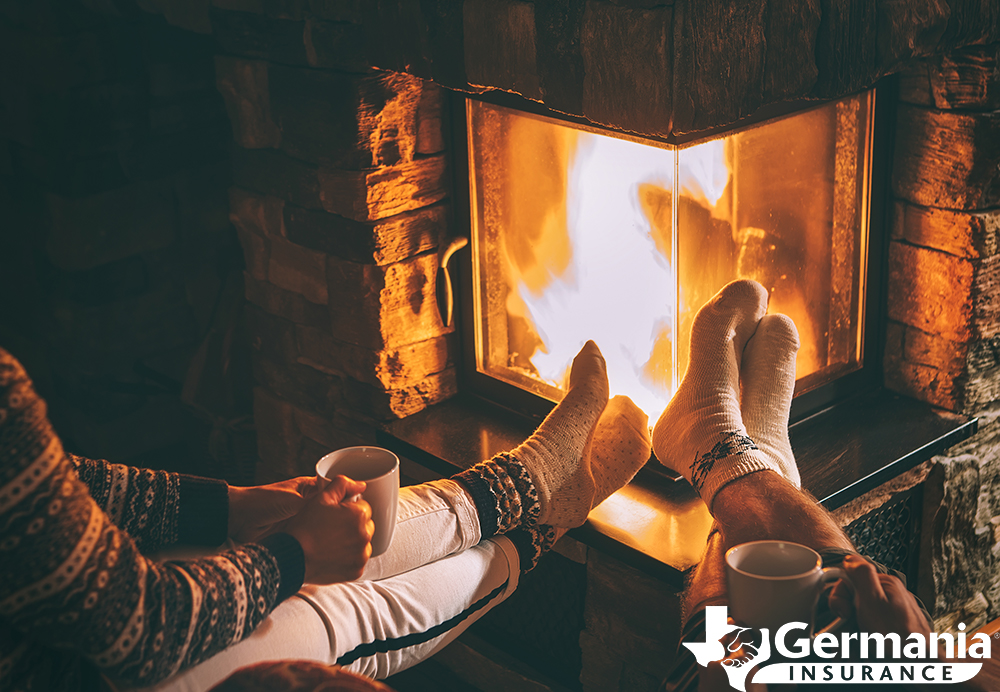What’s the best way to keep warm during a cold
Texas winter? Warm tea and hot cocoa, heated blankets, crackling fires, and handy space heaters are all effective favorites. But each year, half of home
heating-related fires take place during the winter months of December, January, and February. Heating equipment, such as space heaters, stoves, and fireplaces, are involved in 1 in every 7 home fires and 1 in every 5 home fire deaths. That doesn’t mean you have to be cold, however! Check out our guide and learn how to safely heat your home during Texas winters!

Fire Safety
Space Heaters
Kerosene heaters, propane, or other gas heaters can be effective ways to heat an area, especially if you find yourself without electricity. However, because these run on organic fuels, these are generally not recommended for closed spaces (see Carbon Monoxide Safety below). Never use any fuel other than the one your device is designed for.
Electric space heaters are an inexpensive way to warm a problematic cold spot in your house or heat up a small room. In general, they have made great strides in safety, but that doesn’t mean they are without risks.
When shopping for a space heater, look for an option that has tip-over protection (automatic shutoff switch). If you have small children or pets, these are a must. If Mr. Kitty decides to knock over your heater, tip-over protection ensures nothing unexpectedly goes up in flames.
Even if you have safety features on your space heater, they aren’t likely to prevent any nearby objects from potentially catching fire if they’re too close. Make sure to keep anything flammable, such as curtains, blinds, blankets, and paper, at least 3 feet away from any heat source.
Never plug in more than one electric space heater into a single outlet. Most electric space heaters run at about 1500 watts and most outlets allow 1800, which means more than one could be an electrical hazard.
Fireplaces
Make sure your chimney flue isn’t blocked by squirrel nests, bird nests, or any other such obstruction. It’s also a good idea to build a smaller preliminary fire to allow the hot air to rise all the way up through the column before opening the flue. Alternatively, if you have a gas pilot light in your fireplace, you can let that burn short while before adding logs. Otherwise, the dense, cold air could flood in and push the smoke out before it’s had a chance to warm the pathway up and out.
Never store ashes in plastic, paper, or any other flammable containers. Once they’ve cooled, keep them in a metal container and store them in a safe location outdoors. If you’re unsure if the ashes are cool enough to remove, stir them with a fire poker and spread them as thinly as possible. This uncovers any hidden coals and allows them to burn out and cool down. Coals and ashes can stay hot for up to four days if they were insulated or covered well enough!
Keep the protective metal veil in front of your fire place shut at all times to prevent sparks and embers from leaping out. Keep rugs and other flammable objects away from the hearth (remember, at least 3 feet). Try to use hardwood logs rather than softer woods like pine. The sap within can spit and spark and the smoke contains creosote, which can build up in chimneys and create a fire hazard.
Central Heating/HVAC Furnace
HVAC professionals recommend having your system inspected at least once a year. Many of the issues households report with their heating systems can be prevented with routine maintenance. While you should always clean or replace your air filters, there are a number of other aspects, such as wiring, that require professional assessment. Not only does this ensure you’ll be nice and toasty during the colder months, but it can also save you money on energy and make sure that you don’t void your manufacturer’s warranty.
Carbon Monoxide Safety
Carbon Monoxide, or CO, is a common, but potentially deadly gas. Because CO is a byproduct of burning organic material, like kerosene, there are more deaths caused by CO poisoning in the winter months than at any other time of the year.
It’s especially dangerous because it is odorless and invisible. That’s why it’s important to install CO alarms in your home. It’s recommended that you change the batteries when you change your clocks twice a year and replace your CO detector every 5 years.
If you find yourself without electricity and need to use a generator, make sure it’s in a safe location outside of your home to prevent a buildup of dangerous gases. If you use a gas-powered heater, such as kerosene, make sure it is in a well-ventilated area even if its chilly outside.